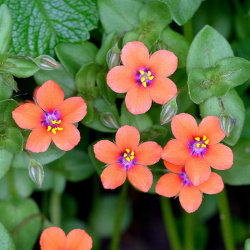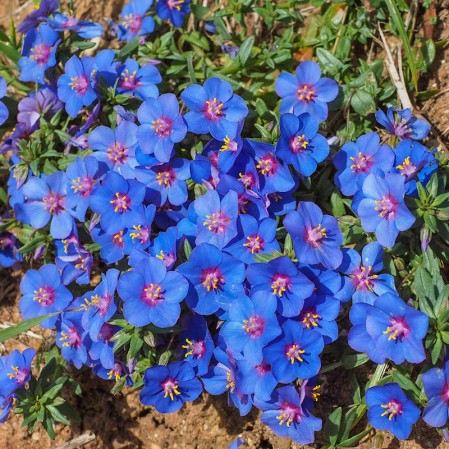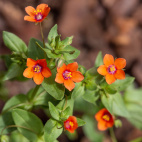Blue Pimpernel Seeds
Anagallis monelli
- HOW TO GROW
- FAST FACTS
HOW TO GROW
Sowing: To start the seeds indoors, sow in a flat on the surface of the soil; keep the soil moist and at a temperature of 65-70 degrees F until germination. Germination usually takes place within 20-30 days. When the seedlings grow big enough to handle safely and there is no chance of frost, transplant them. To direct sow, plant the seeds on the surface of the soil after the last frost; place 3-4 seeds together in a group, and thin to the strongest seedling.
Growing: Water if the soil dries out but do not over water, since this can cause root rot and other diseases. Because of its abundant flowers and tidy growth, this plant grows well in containers or hanging baskets, in rock gardens, or as a border; it will continue blooming until frost. To survive the winter, these plants must be brought indoors or kept at a temperature no lower than 45 degrees F. This flower attracts hummingbirds, butterflies, and bees.
Harvesting: Blue Pimpernel can be toxic even in small amounts, and is not recommended for medicinal or culinary use.
Seed Saving: These plants produce seed for most of the summer, since they bloom from spring to fall. When the flowers fade, seed pods will form. Since the pods split and drop their seeds when completely ripe, the pods should be gathered individually as soon as they begin to dry. Before harvesting, check the pods to make sure the seeds have reached their mature dark brown or black color. Spread the seed pods out to finish drying away from direct sunlight; thresh them to remove the seed. Store the seed in a cool, dry place for 8 years.
FAST FACTS
Common Names: Flaxleaf Pimpernel, Mediterranean Pimpernel
Latin Name: Anagallis monelli
Species Origin: Mediterranean
Type: Garden Flowers
Life Cycle: Annual
USDA Zones: 1, 2, 3, 4, 5, 6, 7, 8, 9, 10, 11, 12
US Regions: California, Mountain, Arid/Desert, Plains/Texas, Midwest, Northern, Northeast, Southeast
Seeds per Ounce: 40,000
Stratification: No Stratification
Germination Ease: No Stratification
Sunlight: Full Sun
Height: 9 Inches
Color: Blue
Bloom Season: Blooms Early Summer, Blooms Late Summer, Blooms Early Fall
Uses: Deer Resistant
DESCRIPTION
HOW TO GROW
Sowing: To start the seeds indoors, sow in a flat on the surface of the soil; keep the soil moist and at a temperature of 65-70 degrees F until germination. Germination usually takes place within 20-30 days. When the seedlings grow big enough to handle safely and there is no chance of frost, transplant them. To direct sow, plant the seeds on the surface of the soil after the last frost; place 3-4 seeds together in a group, and thin to the strongest seedling.
Growing: Water if the soil dries out but do not over water, since this can cause root rot and other diseases. Because of its abundant flowers and tidy growth, this plant grows well in containers or hanging baskets, in rock gardens, or as a border; it will continue blooming until frost. To survive the winter, these plants must be brought indoors or kept at a temperature no lower than 45 degrees F. This flower attracts hummingbirds, butterflies, and bees.
Harvesting: Blue Pimpernel can be toxic even in small amounts, and is not recommended for medicinal or culinary use.
Seed Saving: These plants produce seed for most of the summer, since they bloom from spring to fall. When the flowers fade, seed pods will form. Since the pods split and drop their seeds when completely ripe, the pods should be gathered individually as soon as they begin to dry. Before harvesting, check the pods to make sure the seeds have reached their mature dark brown or black color. Spread the seed pods out to finish drying away from direct sunlight; thresh them to remove the seed. Store the seed in a cool, dry place for 8 years.
FAST FACTS
Common Names: Flaxleaf Pimpernel, Mediterranean Pimpernel
Latin Name: Anagallis monelli
Species Origin: Mediterranean
Type: Garden Flowers
Life Cycle: Annual
USDA Zones: 1, 2, 3, 4, 5, 6, 7, 8, 9, 10, 11, 12
US Regions: California, Mountain, Arid/Desert, Plains/Texas, Midwest, Northern, Northeast, Southeast
Seeds per Ounce: 40,000
Stratification: No Stratification
Germination Ease: No Stratification
Sunlight: Full Sun
Height: 9 Inches
Color: Blue
Bloom Season: Blooms Early Summer, Blooms Late Summer, Blooms Early Fall
Uses: Deer Resistant
Also Consider These:
-
 On Sale!
Out of Stock
Scarlet Pimpernel Seeds
Anagallis arvensis
Quick View
x
On Sale!
Out of Stock
Scarlet Pimpernel Seeds
Anagallis arvensis
Quick View
xScarlet Pimpernel Seeds
Anagallis arvensis
These small, brilliant red flowers simply pop with color. Growing prolifically along the roadsides and meadows of the United Kingdom, this annual has spread to nearly every temperate region on the globe. It is not invasive but will reseed itself readily.
Starting at $3.48 USD







